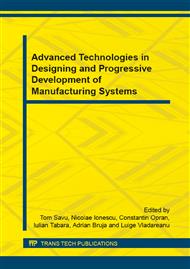[1]
S. Gupta, J. Joseph, Virtual Instrumentation Using LabVIEW, Tata McGraw-Hill Education, (2010).
Google Scholar
[2]
Information on http: /www. ni. com (accessed on August 2014).
Google Scholar
[3]
H. P., Halvorsen, Data Acquisition in LabVIEW, Faculty of Technology, Porsgrunn, Norway, (2013).
Google Scholar
[4]
C. Wang, S.B.C. Ghani, K. Cheng, R. Rakovski, Adaptive smart machining based on using constant cutting force and a smart cutting tool, Proceedings of the Institution of Mechanical Engineers, Part B: Journal of Engineering Manufacture, Volume 227, Issue 2, 249-253, (2013).
DOI: 10.1177/0954405412466233
Google Scholar
[5]
U. Zuperl, F. Cus, M. Reibenschuh, Neural control strategy of constant cutting force system in end milling, Robotics and Computer-Integrated Manufacturing, Volume 27, (2011), 485–493.
DOI: 10.1016/j.rcim.2010.10.001
Google Scholar
[6]
S. Ibaraki, T. Shimizu, A long-term control scheme of cutting forces to regulate tool life in end milling processes, Precision Engineering, Volume 34, (2010), 675–682.
DOI: 10.1016/j.precisioneng.2010.05.001
Google Scholar
[7]
U. Zuperl · F. Cus · M. Reibenschuh, Modeling and adaptive force control of milling by using artificial techniques, Journal of Intelligent Manufacturing, Volume 23, (2012), , 1805–1815.
DOI: 10.1007/s10845-010-0487-z
Google Scholar
[8]
P. Stavropoulos, P. Chantzis, D. Doukas. C. Papacharalampopoulos, A. Chryssolouris, G. Monitoring and control of manufacturing processes: A review, Procedia CIRP, Volume 8, ( 2013 ), 421–425.
DOI: 10.1016/j.procir.2013.06.127
Google Scholar
[9]
A. M. Vasiloni, M. V. Dragoi, Hardware/software architecture for adaptive control systems, Academic Journal of Manufacturing Engineering, Vol. 12, Issue 1, (2014).
Google Scholar
[10]
U. Zuperl, F. Cus, M. Milfelner, Fuzzy control strategy for an adaptive force control in end-milling, Journal of Materials Processing Technology 164–165 (2005), 1472-1478.
DOI: 10.1016/j.jmatprotec.2005.02.143
Google Scholar
[11]
F. Cus, U. Zuperl* Zuperl, E. Kiker, M. MIlfelner, Adaptive controller design for federate maximization of machining process, Journal of Achievements in Materials and Manufacturing Engineering, Volume 17, Issue 1-2, (2006), 237-240.
Google Scholar
[12]
A. Matsubara, S. Ibaraki, Monitoring and Control of Cutting Forces in Machining Processes: A Review, Monitoring and Control of Cutting Forces in Machining Processes.
DOI: 10.20965/ijat.2009.p0445
Google Scholar
[13]
Information on http: /www. kistler. com/ro/en/applications/cuttingforce/overview (accessed on August 2014).
Google Scholar
[14]
A. M. Vasiloni, M. V. Dragoi, Smart Adaptive CNC Machining – State of the Art, Innovative Manufacturing Engineering Conference – ImanE 2014, Chisinau, R. Moldova, (2014).
DOI: 10.4028/www.scientific.net/amm.657.859
Google Scholar
[15]
I. Badan, Utilizarea obiectelor tehnologice inteligente în ingineria produselor, Teza de doctorat, Brasov, (2012).
Google Scholar


